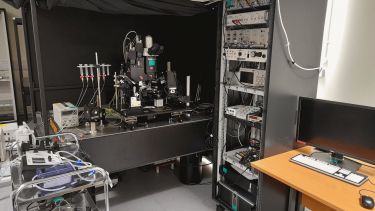Functional imaging
Our current understanding of how auditory hair cells convert sound into electrical impulses and transmit them with high precision to the brain comes from studies on isolated tissue, which lacks crucial functional and morphological elements present in the intact system. This largely limits our knowledge and any future developments towards a cure for hearing-related disorders. We have developed novel approaches to investigate the above mechanisms, which will pave the way for developing treatments for hearing loss and deafness. Click here to find out more.
The processing of sensory information is a fundamental feature of human biology, yet we have limited understanding of how it occurs in vivo. We use advanced imaging (e.g. 2-photon calcium and glutamate imaging) and electrophysiological techniques, combined with in vivo gene delivery and genetically modified mice and zebrafish, to study the function of sensory systems and their synapses in vivo. We use this approach to identify the mechanisms regulating the function of sensory systems, how they change throughout life and how they integrate in the brain to instruct behaviour.
One of our 2-photon microscopes

